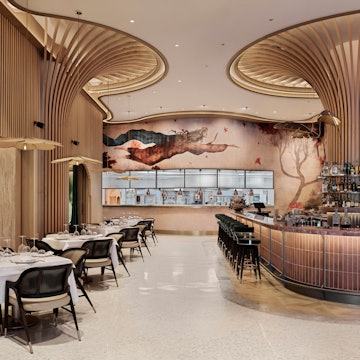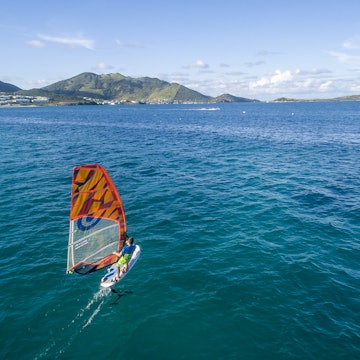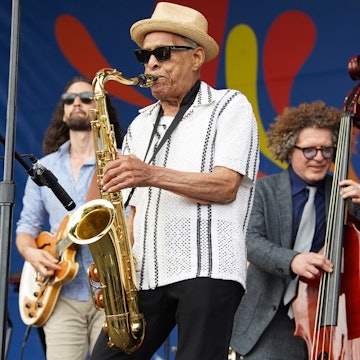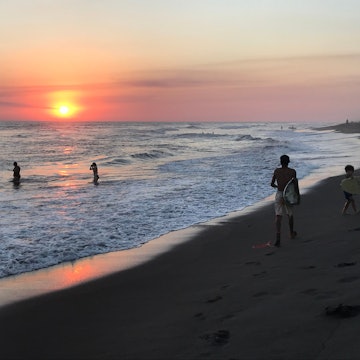

Baobab trees sway at sunset in Madagascar. Dennis van de Water/Shutterstock
Visiting Madagascar can feel like an adventure into the unknown. It’s a country that combines world-class luxury resorts with gems that are situated – barely known to the outside world – down a long and winding dirt track. And everything else in between.
Madagascar is one of the world’s most exciting destinations for watching wildlife. Ever since it broke away from the African mainland to form the world’s fourth-largest island, this beautiful land has gone its own evolutionary way, and the resulting stats are irresistible: 95% of Madagascar’s amphibians and reptiles and 90% of its mammals exist in Madagascar and nowhere else on earth.
It’s a story repeated again and again: Madagascar is utterly unlike any country you’ve ever visited before. As you can imagine, in such a place a little inside knowledge, and even more planning, can go a long way. What follows are our top tips for visiting and exploring this remarkable country.
1. Pick your time of year
Your experience of Madagascar will vary greatly depending on when you visit. Put simply, this is a country where the weather matters.
In this land, which is so vast that some naturalists call it “the Eighth Continent,” conditions differ significantly from one corner of the country to the next. While the south bathes in seemingly eternal sunshine, conditions can be freezing in the highlands that run like a spine down through the heart of the country. In some cases, it’s a question of access: some parts of the country become inaccessible as roads deteriorate into quagmires after heavy rains. On other occasions, it’s a matter of safety: the January-April cyclone season can mean making sudden changes to even the most meticulous travel plans.
On the positive side, planning well is not just about avoiding potential peril. If you’re here to hike or to watch whales, for example, you’ll want to plan a trip sometime between June and September, when the weather and wildlife patterns are ideal for both activities. If, on the other hand, you’re here to dive or snorkel, you’ll want to look seriously at December as the best time to be here. Plan well, and you won’t be disappointed. When it comes to the weather, we have you covered with our guide to the Best Time to Visit Madagascar.
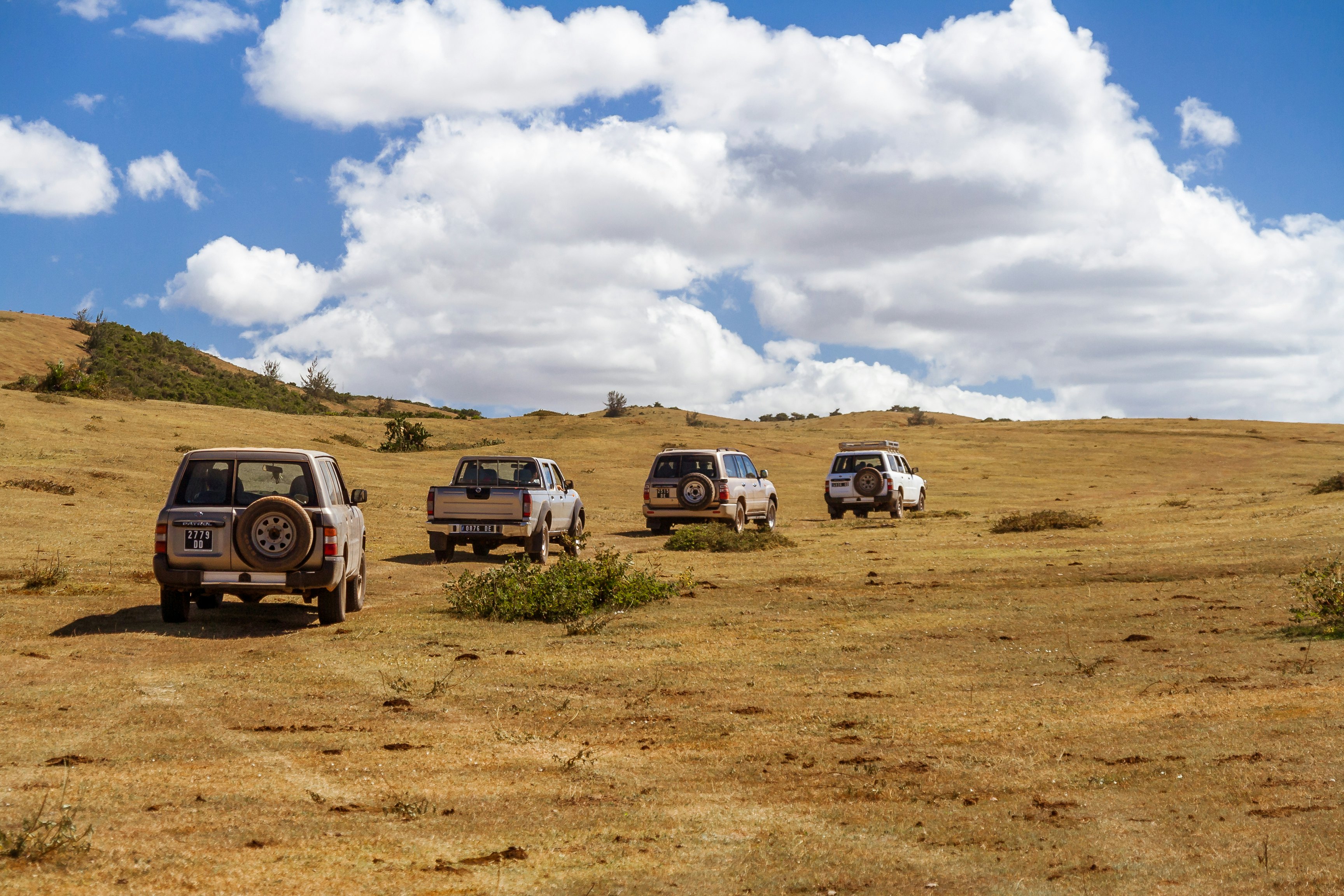
2. Expect bad roads
If there’s one recurring complaint we hear more than any other from travelers to Madagascar, it’s the poor condition of the roads. All across the country, the country’s extensive road network has deteriorated significantly in recent years: axle-breaking potholes are commonplace, and on many roads you can never quite relax whenever you pick up speed. On one recent trip, it took us eight hours to travel 200km in a private car along a major highway in the country’s west. It’s an extreme example, perhaps, and not all roads are this bad; some are even quite good. But it’s also a salutary tale.
Poor roads are a fact of life that affects the lives of ordinary people in Madagascar far more than it does tourists. And to a certain extent, it’s just something you’ll have to learn to live with, as it is one of the trade-offs of traveling in a country that otherwise has so many things that impress.
But knowing about it in advance is important for planning your excursions and wider explorations. In other words, don’t try to do too much in a short space of time, and be realistic about what’s possible. Distances in Madagascar are already vast, so when you add the condition of the roads into the equation, everything just takes a little longer. Factor that into your travel plans, and you’ll be fine.

3. Wildlife planning
If wildlife is a big part of the reason why you’re visiting Madagascar, planning is not just about the weather. You should familiarize yourself with the best times to see your chosen wildlife, whether it’s when the whales show off as they pass by Madagascar’s coast or the months with the clearest visibility for diving and snorkeling.
But especially when it comes to birds and mammals, planning where you go is just as important as planning when you visit. With the limited exception of a few widespread species of lemur – the ring-tailed lemur, for example, is present in many parks – most lemurs are highly localized. If you want to hear the haunting cries of the teddy-bear-like indri fill the forest, for example, plan to visit the parks in the Andasibe region of eastern Madagascar. To see the widest range of lemurs in one place, try Ranomafana National Park in the highlands, or Kirindy Forest in the west, north of Morondava. The latter is also one of very few places in the country where sightings of Madagascar’s largest carnivore, the charismatic fossa, are almost guaranteed.
Instead of relying on the wildly inaccurate wildlife promises of Disney’s Madagascar animated films, buy yourself a field guide to the wildlife of Madagascar, and start choosing what it is you really want to see, and where you have to go to see it.

4. Food planning
Madagascar may not be known as a culinary destination. In fact, it’s all too easy to travel around the country and eat international dishes in tourist hotels and restaurants without ever really sampling the local tastes. But there’s plenty to enjoy if you know where to look and, apart from the food itself, sharing a meal is a great way to meet the locals. If you’re here on a tour, let your tour operator know in advance that local food is a factor.
Even a cursory attempt at picking out the local dishes from a menu crowded with tourist fare can make a difference to your culinary experience. Along the coast, gravitate towards the seafood (octopus salad anyone?), and if you see foza sy hena-kisoa (stir-fried crab, lobster and pork cooked in lime juice and ginger), order it. Inland, it just has to be zebu (the local wild and domesticated cattle) cooked in all manner of forms, included the stew-like romazava, the national dish, or tilapia (a freshwater fish). And how would you know, if no one told you, that Antananarivo is quietly famous for its pastry shops?
Sometimes it’s less about the dish and more about the experience of eating in one of Madagascar’s best restaurants. Whether it’s La Varangue or Marais Restaurant (Antananarivo), Le Tsara Be Vaovao (Antsiranana region, also known as Diego Suárez) or Mad Zebu (Belo-sur-Tsiribihina), some are worth crossing the country to try.

5. Etiquette in Madagascar
Madagascar’s diverse people have an extraordinarily rich cultural life, with some fascinating rite-of-passage ceremonies occupying a privileged place in the calendar for local people. But these are driven by deeply held beliefs and are not performances for tourists: you should only attend such a ceremony if expressly invited, and never take pictures without asking. If you’re traveling with a guide, ask them (or a trusted local) to explain some of the intricate local social and cultural taboos (fady) that relate to food, behavior and certain times of the year. And never point or bend your finger to indicate direction, considered rude – use the palm of your hand instead.
Locals, especially those who work in tourism, won’t expect you to get everything right. But at least trying to get it right goes a long way to breaking down barriers between you and local people.
Some customs are easier to fulfil. Greetings are considered important – when meeting a local for the first time, take the time to greet them warmly (follow your lead from them as to whether to shake hands) and ask how they are, how their family is, and so on. And if you’re lucky enough to be invited to someone’s home, bring rice or a bottle of rum for your hosts.
6. Check travel advisories
While Madagascar is overwhelmingly safe to visit, from time to time there are localized concerns that you should be aware of. Sometimes this relates to a rise in pickpocketing in major cities, perhaps a rise in local unrest or banditry after dark along certain roads. Local tour operators will know better than anyone about local conditions. But check, too, the travel advisories of governments, specially those with embassies in the country, such as France, the U.S. and U.K., which reliably note specific safety incidents and their impact upon the safety of visiting travelers.
7. Visa on arrival
Entering Madagascar couldn’t be easier – visas valid for 15 days, 30 days or 60 days are available on arrival for most nationalities at all international airports. Visa fees vary depending on how long you plan on staying, but you'll need to pay in cash in euros or U.S. dollars – bring a range of different notes. Don’t be surprised if your friendly immigration official asks under his or her breath for a small gift or claims to not have change – decline or persist politely and you’ll soon be waved through.
8. Bring cash
Although you can use credit cards (Visa and MasterCard) in high-end restaurants, hotels and some tourist shops, cash remains king in Madagascar. Your best bet is to bring euros and U.S. dollars in a wide range of denominations, which you should be able to change in banks (the best rates but limited opening hours), private foreign exchange offices (open on weekends but they offer slightly lower rates) or through your tour operator. Some tour operators, hotels or shops will accept U.S. dollars or euros for large transactions. The Société Générale Madagasikara (SGM) sometimes exchanges other currencies, but don’t count on it.





